
Logic Inputs and Output settings allow users to configure actions in both the Qt X platform and with connected 3rd party devices. The two primary purposes of the Logic IO are as follows:
Trigger an action as an 'input' within the Qt X platform
Trigger a 3rd party external device as an 'output' from the Qt X platform
Logic functions are available from the Devices tab on the Configuration window:
The following settings are available in both the Qt X software and the Web UI within the Logic user interface for all Qt X control processors:
Two Assignable GPIO Contacts
Contact Inputs (Push to Talk & Emergency Mute)
Privacy Sign Outputs
Note: The Logic Page option (GPIO input) is only configurable in the Qt X software, not in the Qt X WebUI because it pertains to NPX devices.
The Push to talk options (dedicated and GPIO) are prioritized numerically. The lower the number, the higher priority. For example, if there are multiple paging microphones in a system connected to the same zones, the microphone (Audio Source) with the lowest number priority will override any other audio. Emergency Mute overrides all audio in a system, regardless of the priority set.
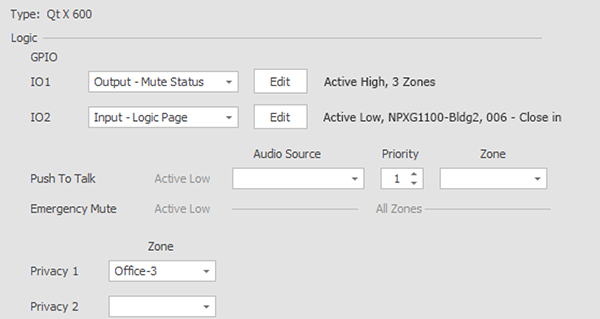
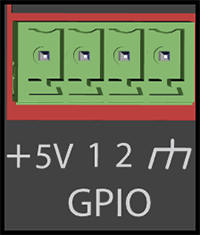
Two GPIO contacts may be configured as an input or output trigger in either an 'Active Low' or 'Active High' state. This allows 'events' to be triggered to offer functionality within the the Qt X (as an input) or to indicate a condition within the Qt X (as an output). Each GPIO selection will have its own dialog box to configure the contact. The default state for most of the options is 'Active High', check the box to apply an 'Active Low' state. The individual input / output functions are described below:
NOTE: The top socket labeled +5V is reserved for future use.
When connected and set to 'Active Low' in software, the zones selected will mute sound masking, background music and paging sources (muting all sound) upon a contact closure (when the circuit is closed).
In the state shown below all audio is muted to the selected zones when the circuit is closed:
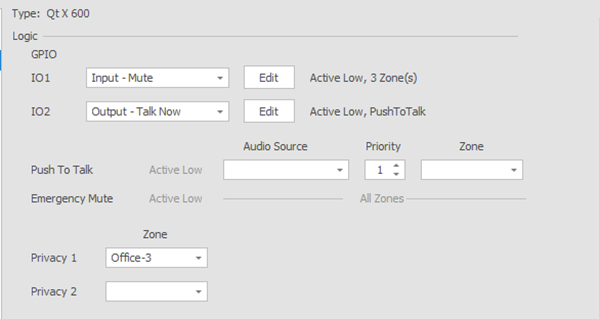
Although there are likely few, if any, practical use cases, if set to 'Active High' in software (Active Low not checked,) all sources will mute when the contact is open.
IMPORTANT: Mute functionality should only be used in situations where it is permissible to disable a zone in very particular instances, such as a conference room with audio conferencing technology. Sound masking should never be muted in areas where building occupants may be present
When connected and set to 'Active Low' in software, the audio source shown ('Phone Page' in the example) will be sent to all zones selected when the contact is closed. This mutes background music in the selected zones; the audio source chosen will play and is adjustable on the Zone Paging Level control.
Although 'Active Low' would be the most common use-case, 'Active High' may be applied as necessary. Changing the state to 'Active High' (Active Low not checked) will route the selected audio source to the selected zone(s) when the contact is open. A connected paging mic would be live at all times, so this use case may be limited to instances where a microphone receptacle is located in a space and is connected for a specific purpose/time (such as a lunch room or other space that may require amplified speech for meetings, etc.).
In the state shown below, when the circuit is closed, audio will stream to the selected zones:
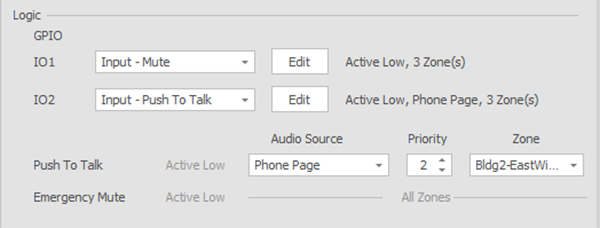
Note that Push to Talk behavior on the GPIO contact two is identical to the fixed Push to Talk but different zones may be selected.
Creating numerous push to talk logic flows will enable a capable analog mic to page specific zones when depressing one push to talk button on the mic. Depressing all buttons on a capable mic (such as Biamp's MICPAT) could be designed as an 'all page' for sending audio to all connected zones.
Note that any audio source available (with 'page' intents) could be assigned when 'Push to Talk' is selected (such as background music), yet this would have little to no practical use cases. If background music were selected as the audio source for push to talk, volume control would be done via the paging level control, not the background music level control.
Setting up a Logic Page requires that there be at least one (1) recorded page be available. The recorded page can be added from the Page Codes tab in the Configuration pane. First select Logic Page from the drop down list, then press 'Edit' to configure the logic page. Choose the NPX station and the Page Code from the drop down lists. As with other GPIO functions, a Logic Page can be configured to trigger on a low logic signal (check 'Active Low'). The default is to trigger when the logic moves to a "High" state. Then press OK to save the setting.
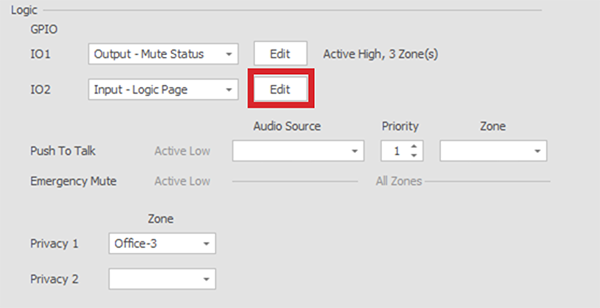

Once a page has been assigned as a Logic Page it will appear in italics and greyed out in the Page Code List. Changing the settings for that page code will be restricted as long as it is assigned as a Logic Page.
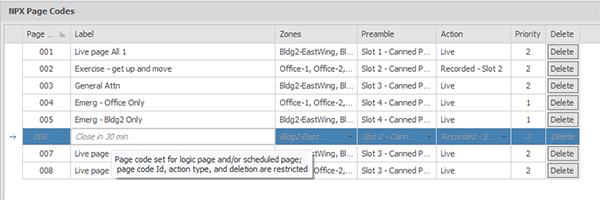
When selected as an output, this function will provide an indication of the state of the Push to Talk (contact input #2) or any available IO port that has been configured as an Input - Push to Talk. The associated port is determined by the selected device listed in the Audio Source drop down. This allows function such as indicating a person may speak into a microphone by illuminating an LED (+5 VDC) when a specific push to talk contact is active.
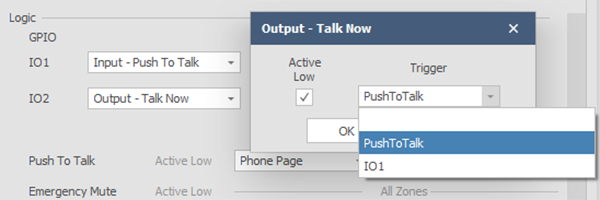
Connect Pin 1 or 2 (depending on the IO output port) and Ground (  ). If software is in an 'Active High' state, the connected LED will illuminate when the associated push to talk input is active. Selecting 'Active Low' in software will provide +5 VDC to the Talk Now output port when the associated Push to Talk input is inactive, thus indicating a paging microphone standby condition.
). If software is in an 'Active High' state, the connected LED will illuminate when the associated push to talk input is active. Selecting 'Active Low' in software will provide +5 VDC to the Talk Now output port when the associated Push to Talk input is inactive, thus indicating a paging microphone standby condition.
Provides an indication of the GPIO Input Mute condition present in a specific zone. When in an 'Active High' state ('Active Low' unchecked,) a mute initiated by the GPIO input on any of the selected zone(s) will result in +5 VDC across Pin 1 or 2 (depending on the output port) and Ground (  ).
).
If the output is set to 'Active Low,' this will indicate the selected zone is not muted.
Although the practical use cases are limited, setting the Mute to Active Low will result in all zones muted unless the signal is closed.
IMPORTANT: Mute functionality should only be used in situations where it is permissible to disable a zone in very particular instances, such as a conference room with audio conferencing technology. Sound masking should never be muted in regularly-occupied areas.
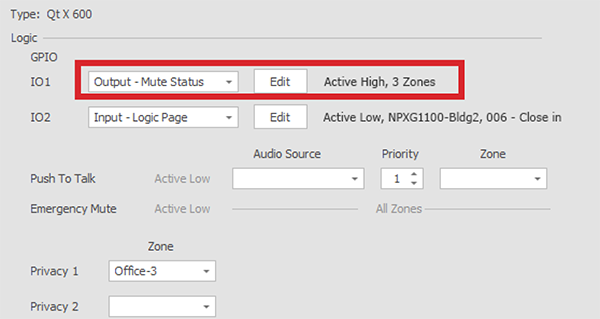
Two logic contacts are fixed as inputs with specific functionality. In software, only the Push to Talk priority and zone outputs are editable (emergency contact is always priority 1 to all zones.)

Note: Although the back panel layouts vary on the different Qt X devices, the contacts and pin-outs are the same:
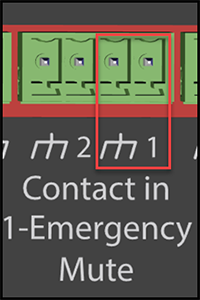
When an incoming signal is closed (Active Low) all sound masking zones, background music sources and paging will be muted. This mode activates when wires connected at Pin 1 and Ground (  ) as shown above are closed (shorted).
) as shown above are closed (shorted).

When an incoming contact is closed (Active Low) the audio source shown will be sent to all zones selected in the Zone drop-down. This results in muting of any background music in the selected zones. Paging will occur in the same zones at the level selected from the zones tab (paging).
The device toggles between the background music and the paging. In order to hear/adjust paging levels the contact must be closed (a connected paging mic live) and adjustments made to the paging level in the appropriate zone.
Note that Push to Talk behavior on contact two is identical to the GPIO Push to Talk described below, but Active Low is the only option.

Two ports are provided to interface with privacy lights panels. They may be designated to 2 different zones and should be home run from the controller to the privacy panel.
5 VDC outputs are available to indicate sound masking is active on a specific zone as indicated by privacy lights. The functionality is as follows;